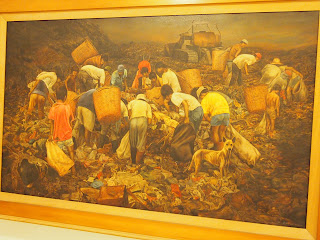My guest was an American woman who is voraciously interested in the visual arts. She even told me she collects at least one art piece from every country she visits. From the looks of it, she's been to a lot of countries. Our driver Bong knew how to get to Agono but didn't know the stops. I knew Angono but had gotten overwhelmed by the great strides of urban development that had taken place in the area.
Roads were definitely wider and traffic flow was quite pleasant even in the Pasig-Rosario junction. Once in Angono, we sort of drove around till we reached a sign towards the Blanco Family museum. It would have been easy if the road had not been blocked by a lamp post repair work. My guest and I had to walk the remainder of the block till we got to the museum. I had to ask for directions from the locals. Blanco Family Museum had undergone renovations over the years. I was looking for a sprawling home of logs and woven rattan strips (sawali) with a wide fish pond out front. The museum is mostly concrete now... the pond hidden by the courtyard.
The museum attendant was very helpful. She kept turning the lights off while we were going through the art pieces. I commented to her that she reminded me of the dear departed Mrs. Blanco who had the habit of turning lights on and off while guests were touring her home to conserve energy. The attendant just smiled and said I was right as Mrs. Blanco was the same person who trained her.
Meanwhile my guest was eagerly snapping photos of the paintings as we exchanged our ideas on the quality of the works created by the Blanco children. She was in awe of the technique they had acquired at such a young age. At one point she commented to me that the chiaroscurro of one madonna and child portrait was amazingly european looking but with asian models. She laughingly agreed on my comment that it was a Filipino counterpart of a Vermeer work. The other piece was of an Aeta madonna and child. It had showcased the olive skin of the woman and the light illuminating her face. It was too life-like for my guest she took photos of that piece.
As we went through all the art work it progressed from the youngest child with the finale leading to Jose "Pitok" Blanco's works. His earlier works showed Botong's influence on his art until he developed a style of his own. He had the great foresight to share his talent with his family and allowed them to work alongside him in some of his murals either as models or as collaborative artists. The Blanco children learned to wield a paintbrush even before they were old enough to go to school.
The extra treat was the guest and myself were introduced to Michael Blanco who had arrived at the museum. Apparently, the children have a hand in running both the museum and the Blanco Academy ( where the arts are incorporated into the curriculum). How smart is that?








No comments:
Post a Comment